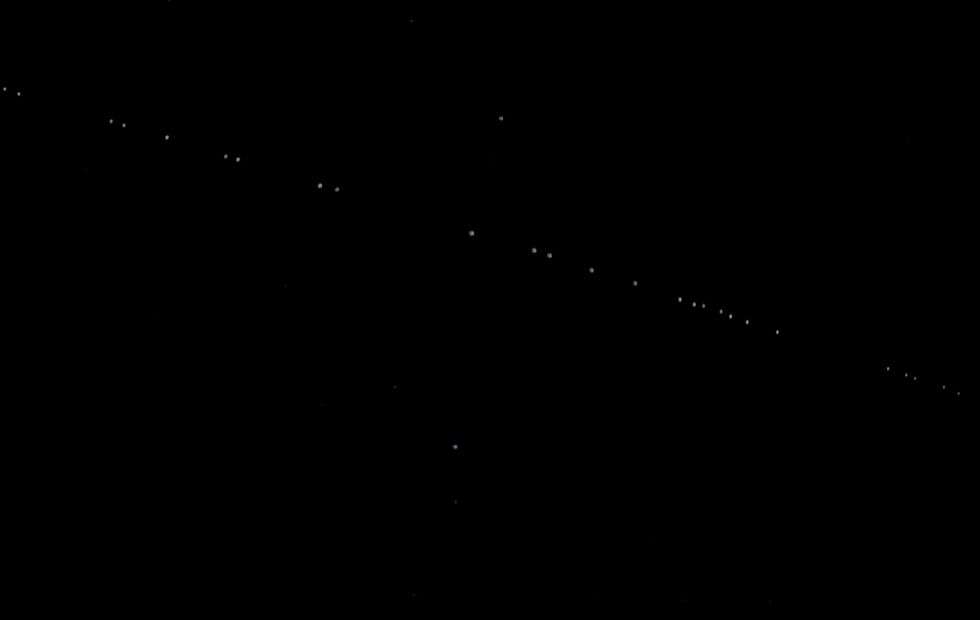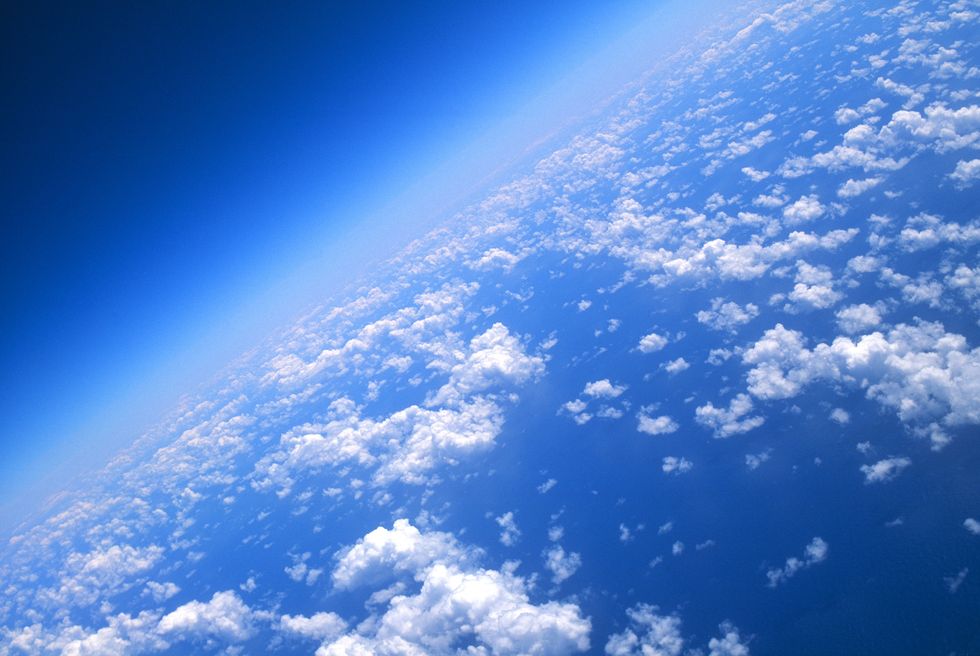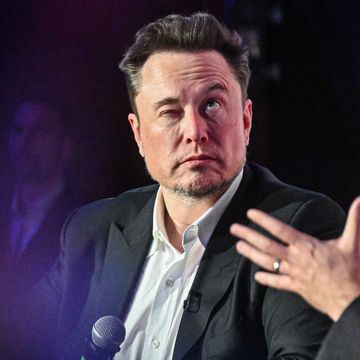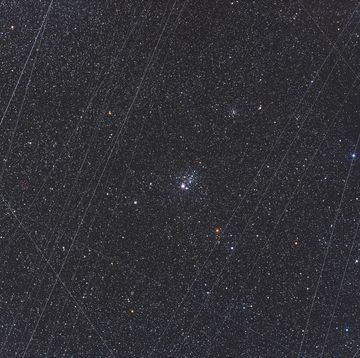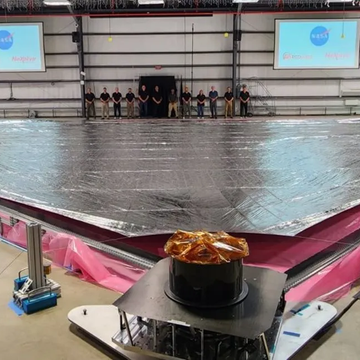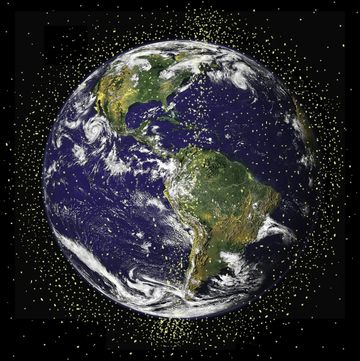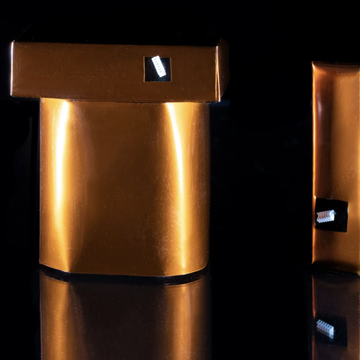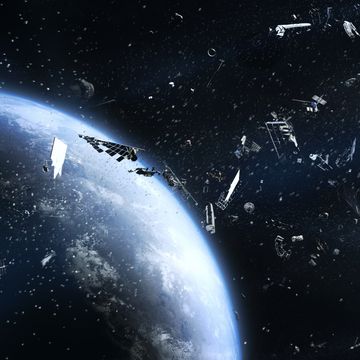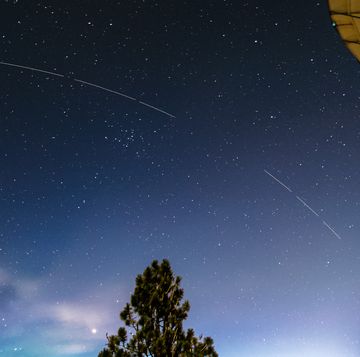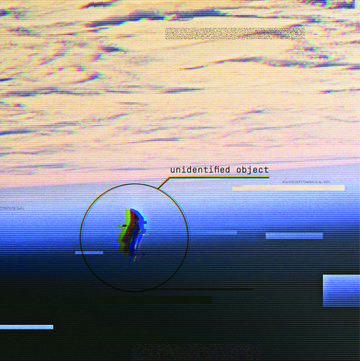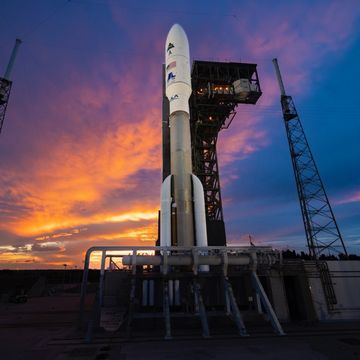- A huge number of low-Earth orbit satellites could cause environmental problems.
- Byproduct aluminum oxide reflects sunlight and helps to deplete ozone.
- There are unintended consequences in legality and even the study of astronomy.
The hole in the ozone layer, Earth’s protective chemical shield that absorbs most of the sun’s ultraviolet rays, has slowly healed over the last few decades since the global ban of chlorofluorocarbons (CFCs). But scientists are now raising the alarm about puncturing a new hole in the ozone layer—this time without any noticeable CGCs in sight.
Dive deeper. ➡ Get unlimited access to Pop Mech's best-in-class space content, starting now.
Instead, the surprising cause is deterioration of the aluminum in megaconstellation satellites like SpaceX’s Starlink network.
For our purposes, a satellite is a human-made object put into low-Earth orbit (LEO) for a planned lifespan. There are about 5,000 active and defunct satellite sin LEO, with over 40,000 Starlink sats planned in the future, plus satellite projects from national space agencies and private companies around the world, researchers from the University of British Columbia say in their new Scientific Reports study.
The human-made distinction may seem obvious, but it hasn’t always been. That’s because, as Space.com reports, scientists spent decades favorably comparing satellite “junk” to the amount of material deposited and burned up in our atmosphere by meteorites. As long as meteorites were so much more of the material by volume while doing almost no harm to the planet, how bad could human-made satellites be?
Well, as it turns out, it’s a matter of quality rather than quantity. That’s because meteorites are made of a different constellation of minerals and elements than our custom-manufactured sky robots.
“We have 54 tonnes (60 tons) of meteoroid material coming in every day,” lead study author Aaron Boley told Space.com. “With the first generation of Starlink, we can expect about 2 tonnes (2.2 tons) of dead satellites reentering Earth’s atmosphere daily. But meteoroids are mostly rock, which is made of oxygen, magnesium and silicon. These satellites are mostly aluminum, which the meteoroids contain only in a very small amount, about 1 [percent].”
Aluminum is key to everything at stake here. First, it burns into reflective aluminum oxide, or alumina, which could turn into an unwitting geoengineering experiment that could alter Earth’s climate. And second, aluminum oxide could damage and even rip a new hole in the ozone layer. Let’s look at each threat separately and try to figure it out.
Misadventures in Geoengineering
Geoengineering is the umbrella term for technologies that seek to alter the climate or other physical realities about the planet. The major meaning that most people associate with the word is solar geoengineering, an experimental idea to fight climate change. Yes, this includes launching reflective aerosols that will “block the sun” back into space and ostensibly cool the planet, which is what Bill Gates eventually wants to try.
But we just don’t know how large-scale geoengineering could affect the planet’s climate. (In the sci-fi flick Snowpiercer, geoengineering has turned Earth into a lifeless iceball whose only survivors must crowd aboard an unceasing train. That’s probably our worst-case scenario.)
Aluminum oxide scatters more light than glass, with a refractive index of about 1.76 compared with just 1.52 for glass and about 1.37 for plain aluminum. The researchers write:
“Anthropogenic deposition of aluminum in the atmosphere has long been proposed in the context of geoengineering as a way to alter Earth’s albedo. These proposals have been scientifically controversial and controlled experiments encountered substantial opposition. Mega-constellations [of satellites] will begin this process as an uncontrolled experiment.”
Another Hole in the Ozone?
What, then, of the ozone layer? Once again, aluminum oxide comes to the forefront. As aluminum burns, it can chemically react with ozone in the air to form aluminum oxide, thereby depleting the naturally protective supply of ozone in the atmosphere. The atmosphere can absorb a small amount of these chemicals without ill effect, but with tens of thousands of satellites in play, the quantities will naturally go up.
That’s in addition to the ozone damage done by each rocket launch to put satellites into LEO. “Rockets threaten the ozone layer by depositing radicals directly into the stratosphere, with solid-fueled rockets causing the most damage because of the hydrogen chloride and alumina they contain,” the researchers write.
While satellites typically dissolve above the stratosphere where most ozone is contained, the particulate can drift down into the stratosphere in order to react there with ozone, scientist Gerhard Drolshagen, an expert on meteoroid material, told Space.com. Aluminum oxide will sink to that level and subsequently cause losses.
An Uncertain Future
So, where does all of this leave us? Well, a huge number of satellites are already approved to be launched in coming years—if anything, this study will help us better understand some of the eventual consequences of that. It’s filled with descriptions of existing space-governing laws (or lack thereof) with commentary about what could change.
First, the authors say, is an inadequate policy governing end-of-life rules for satellites. Something stricter would take into account all the factors associated with, like with Elon Musk’s Starlink megaconstellation, a huge array of satellites that are made to frequently be replaced.
Second, the Inter-Agency Space Debris Coordination Committee recommends, but cannot enforce, that satellites include collision avoidance and deorbiting technologies that add cost. It’s easy to see how that cost stacks when tens of thousands of satellites are planned at once.
The lack of a unified body of rules is a huge problem, the researchers write:
“National regulators such as the FCC are assigning orbital shells to mega-constellations on a first come, first served basis, without assessing the effects on other countries. These could include making any addition of further satellites to those shells too dangerous to contemplate.”
The researchers also say the high number of planned satellites is a threat to simple astronomy, because of the light pollution and effective sky clutter created by these satellites. “[T]here is little recognition that Earth’s orbit is a finite resource, the space and Earth environments are connected, and the actions of one actor can affect everyone,” they conclude. “Until that changes, we risk multiple tragedies of the commons in space.”
🎥 Now Watch This:

Caroline Delbert is a writer, avid reader, and contributing editor at Pop Mech. She's also an enthusiast of just about everything. Her favorite topics include nuclear energy, cosmology, math of everyday things, and the philosophy of it all.

